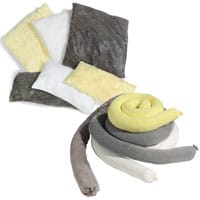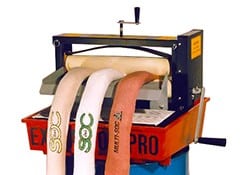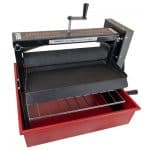Why an Absorbent Wringer Makes an Excellent Investment for Your Facility
How do you get more out of your absorbents? And how do you create efficiencies for your bottom line, including reducing waste? If these questions sound familiar to your business, this week’s post is for you!
Too often, companies lose materials because of an inability to recover valuable resources after absorption. For example, following an accidental oil spill. Or, during day-to-day overflow leakage while handling coolants and hazmat liquid chemicals.
Which prevents those companies from meeting environmental standards. By forcing them to waste fluids when they could be recycling them.
Likewise, the expense of using universal absorbent socks, pillows or pads only once before disposal quickly adds up. As do the monthly bills of paying for trash removal services.
However, using a hand wringer for sorbents can easily solve these problems. Not only will absorbent materials last longer, but you can also keep and reuse the liquids you recover.
What are the benefits of using a wringer for absorbents?
Here are just a few of the great reasons to consider investing in an absorbent wringer today:
It pays itself off quickly
On average, the Environmental Protection Agency (EPA) reports that a hand wringer pays for itself in just three to five short weeks.
Those cost savings quickly add up through spending less on supplies along with reducing your waste disposal costs. Enjoy buying your absorbents by the box instead of high-volume pallets!
Help your business go green!
A hand wringer allows you to recycle fluids, improving your environmental compliance. This efficient chemical recovery and collection system aids waste stream separation.
Not only that, you’ll meet waste minimization goals by sending fewer materials to landfills. Which can also help minimize risks of them potentially leeching toxic hazmat chemicals.
Save money on annual operation spend
By employing a hand wringer at your facility, the EPA reports that you can achieve annual savings of 51-75%. That is to say, you’ll spend less on purchasing brand-new absorbent pads, socks, and pillows.
Not to mention reducing outlays on chemicals you use at your facility. That’s because you can easily recover fluids so they last longer and you don’t need to buy them as often. As well, you’ll be reducing your monthly bill for waste disposal management services.
Which absorbents can you wring and re-use?

Squeeze and re-use the contents you commonly find in workplace spill kits
Absorbent socks, mats, pads, and pillows are just a few spill-cleanup supplies you can wring out and reuse. This means you’ll be able to extend the service life of the most common contents found in spill kits.
In addition, you can also speed up the drying process for wet industrial floor or ground protection mats. As well as your fabric shop rags and wipes.
Once you finish a spill cleanup, be it from an IBC or drum leak, pass your wet sorbents through the extractor. You’ll easily recover and recycle the otherwise oil spill wastage fluids!
Note that any liquid materials you wish to recover must be non-flammable. Which typically excludes many solvents, paints, or combustible fuels.
Hand wringer model features
If you’re ready to pick up a hand wringer, AbsorbentsOnline is here to provide them. Choose the optional hands-free electric motor drive, or, the base Pro model by itself. Featuring heavy steel construction and parts, these units are made in the USA.
This Pro Model wringer incorporates several features to minimize waste. Its 19-inch rollers accept 18-inch pads with no folding, or as many as four 3-inch socks at one time. Spring-loaded rollers provide pressure in both directions making it easier to start thick items like socks and pillows.
It can also accept 5-inch, 6-inch, and some 8-inch absorbent booms. The Pro model’s optional electric motor drive provides hands-free wringing—say goodbye to hand-cranking!
How to use a hand wringer for absorbents
The pad wringer easily attaches to a standard 55-gallon collection drum. Depending on the materials you plan to recover, you can use either a stainless steel or polyurethane closed-head drum.
Much like tension mop-heads, an absorbent wringer uses compression to extract and recover liquids. A manual hand crank pushes sorbents through the wringer unit. As materials pass through the heavy-duty rollers, they squeeze out and recover excess fluids in your collection drum.
By engaging the tension dial you can adjust the roller widths between 12 and 19 inches. This means the unit will easily accommodate larger absorbent pillows or booms.
However, you may need to wring out thicker items like absorbent booms several times. Allow super absorbent socks or mats to hang and air dry before re-use. This is particularly relevant for sorbents you use with water-based fluids. Like absorbent floor mats in wet kitchen environments.
Tip: try feeding both ends of an absorbent sock through the unit’s rollers at the same time. This helps prevent socks from bursting during the wringing process.
Your spill containment and clean-up supply experts
No matter what you need from a hand wringer, AbsorbentsOnline can help. By recycling and reusing your absorbents you’ll save money and the earth!
We also offer a wide range of complimentary spill containment supplies. From overpack drum spill kits, to berms or pallets. Along with competitive pricing on facility maintenance products. Including dispensers, drain covers, and roll racks.
Want to learn more about spill control and waste minimization for your business at affordable pricing? Contact Travis Zdrazil at travis@absorbentsonline.com or (800) 869-9633.
This is a revision to a blog post with an original publication date of November 24, 2015

